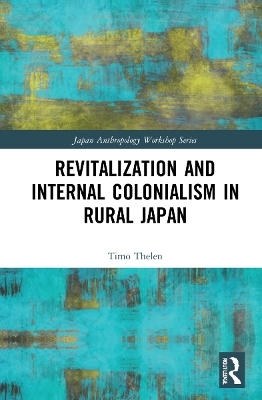
Revitalization and Internal Colonialism in Rural Japan
Seiten
2022
Routledge (Verlag)
978-1-032-19871-2 (ISBN)
Routledge (Verlag)
978-1-032-19871-2 (ISBN)
This book explores the decline of rural and peripheral areas in Japan which results from an aging population, outmigration of the younger generations, and the economic decline of the primary sector.
This book explores the decline of rural and peripheral areas in Japan, which results from an aging population, outmigration of the younger generations, and the economic decline of the primary sector. Based on extensive original research, the book examines in detail the case of the Noto peninsula. Allowing the locals to tell their stories, describe their problems, and come up with possible solutions, the book demonstrates the serious impact of rural decline on their daily life and work and highlights the struggle to sustain rural living in the globalized age. It argues that some recent innovations in global media, economy, technology, and ideology offer scope for reversing the decline, as some central government initiatives do, but that these are not always noticed, appreciated, and made use of by local people. The book also discusses the nature of the links between the peripheries and the centres – regional, national, and global – and how these often take the form of "internal colonialism."
This book explores the decline of rural and peripheral areas in Japan, which results from an aging population, outmigration of the younger generations, and the economic decline of the primary sector. Based on extensive original research, the book examines in detail the case of the Noto peninsula. Allowing the locals to tell their stories, describe their problems, and come up with possible solutions, the book demonstrates the serious impact of rural decline on their daily life and work and highlights the struggle to sustain rural living in the globalized age. It argues that some recent innovations in global media, economy, technology, and ideology offer scope for reversing the decline, as some central government initiatives do, but that these are not always noticed, appreciated, and made use of by local people. The book also discusses the nature of the links between the peripheries and the centres – regional, national, and global – and how these often take the form of "internal colonialism."
Timo Thelen is an Associate Professor in the School of International Studies, Kanazawa University, Japan.
Introduction: The Peripheries—Why They Suffer, Why They Matter 1. National Transformation: Satoyama Satoumi and Japan’s Green Dawn 2. National and Global Discourses: The Four Gazes of Satoyama Satoumi 3. Translocal Transformation: How Noto Was Turned into Satoyama Satoumi 4. Translocal Rediscovery: Bringing Satoyama Satoumi Back to the Hinterland 5. Local Links I: The World Was Their Oyster 6. Local Links II: The Postmodern Mermaids 7. A (Post)colonial System: Translations Between Centers and Peripheries Conclusion: Rethinking Rural Revitalization and Internal Colonialism
| Erscheinungsdatum | 08.04.2022 |
|---|---|
| Reihe/Serie | Japan Anthropology Workshop Series |
| Zusatzinfo | 24 Halftones, black and white; 24 Illustrations, black and white |
| Verlagsort | London |
| Sprache | englisch |
| Maße | 156 x 234 mm |
| Gewicht | 453 g |
| Themenwelt | Naturwissenschaften ► Biologie ► Ökologie / Naturschutz |
| Naturwissenschaften ► Geowissenschaften ► Geografie / Kartografie | |
| Sozialwissenschaften ► Soziologie ► Spezielle Soziologien | |
| ISBN-10 | 1-032-19871-0 / 1032198710 |
| ISBN-13 | 978-1-032-19871-2 / 9781032198712 |
| Zustand | Neuware |
| Informationen gemäß Produktsicherheitsverordnung (GPSR) | |
| Haben Sie eine Frage zum Produkt? |
Mehr entdecken
aus dem Bereich
aus dem Bereich
Planung · Recht · Verfahren
Buch | Hardcover (2024)
Springer Vieweg (Verlag)
64,99 €
Grundlagen, Systeme, Anwendung, Wirtschaft
Buch | Hardcover (2024)
Carl Hanser (Verlag)
99,99 €


